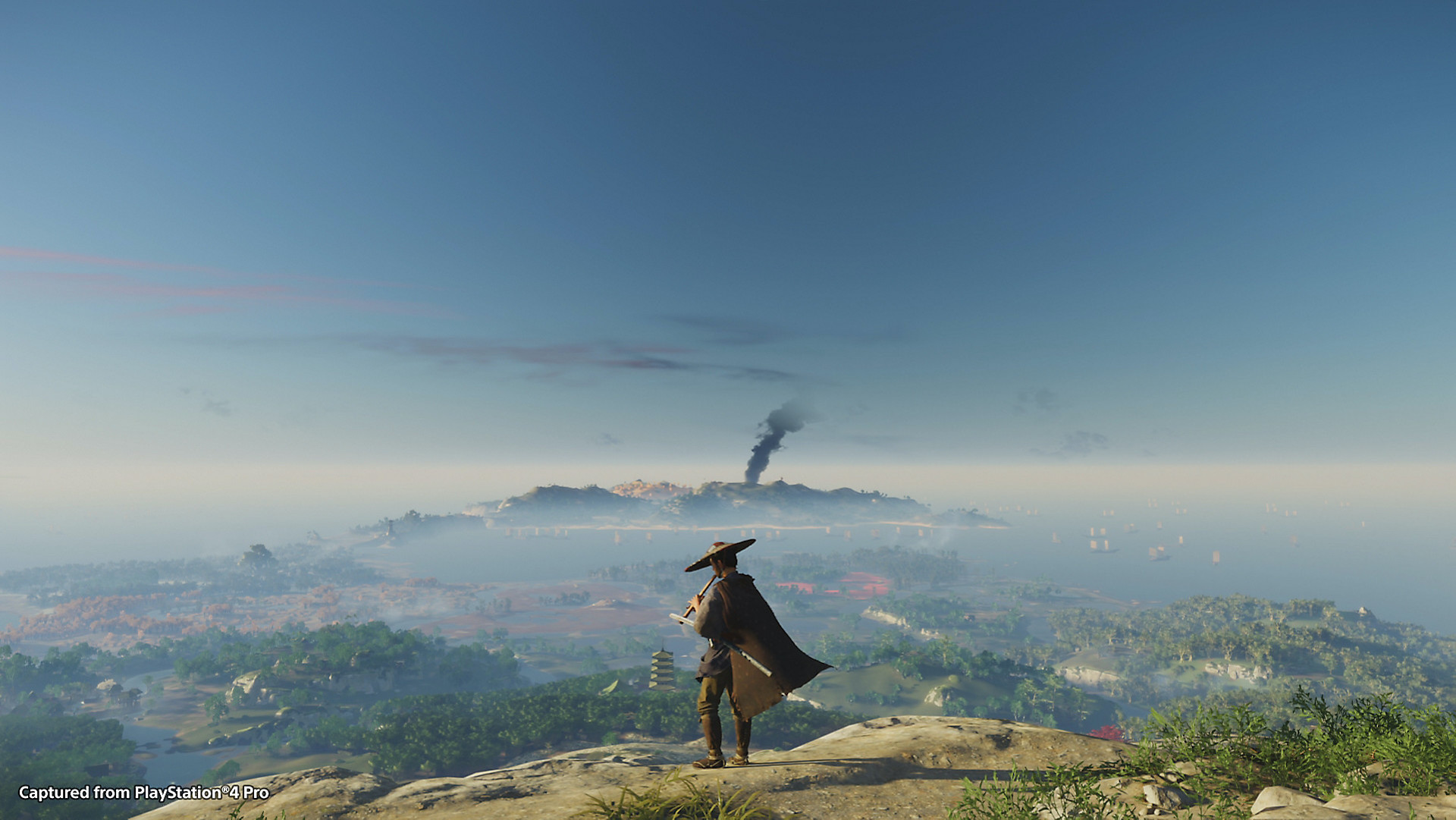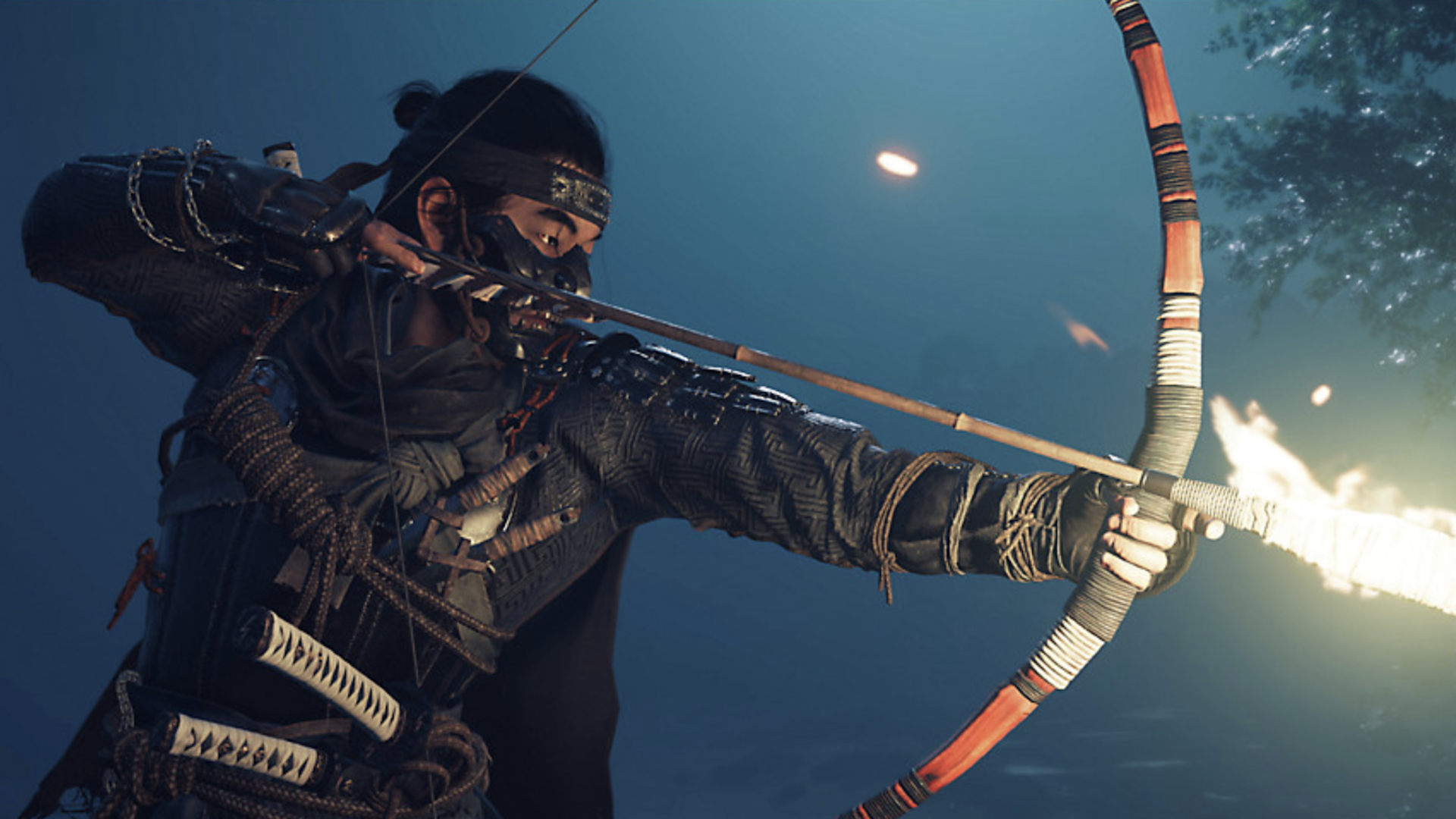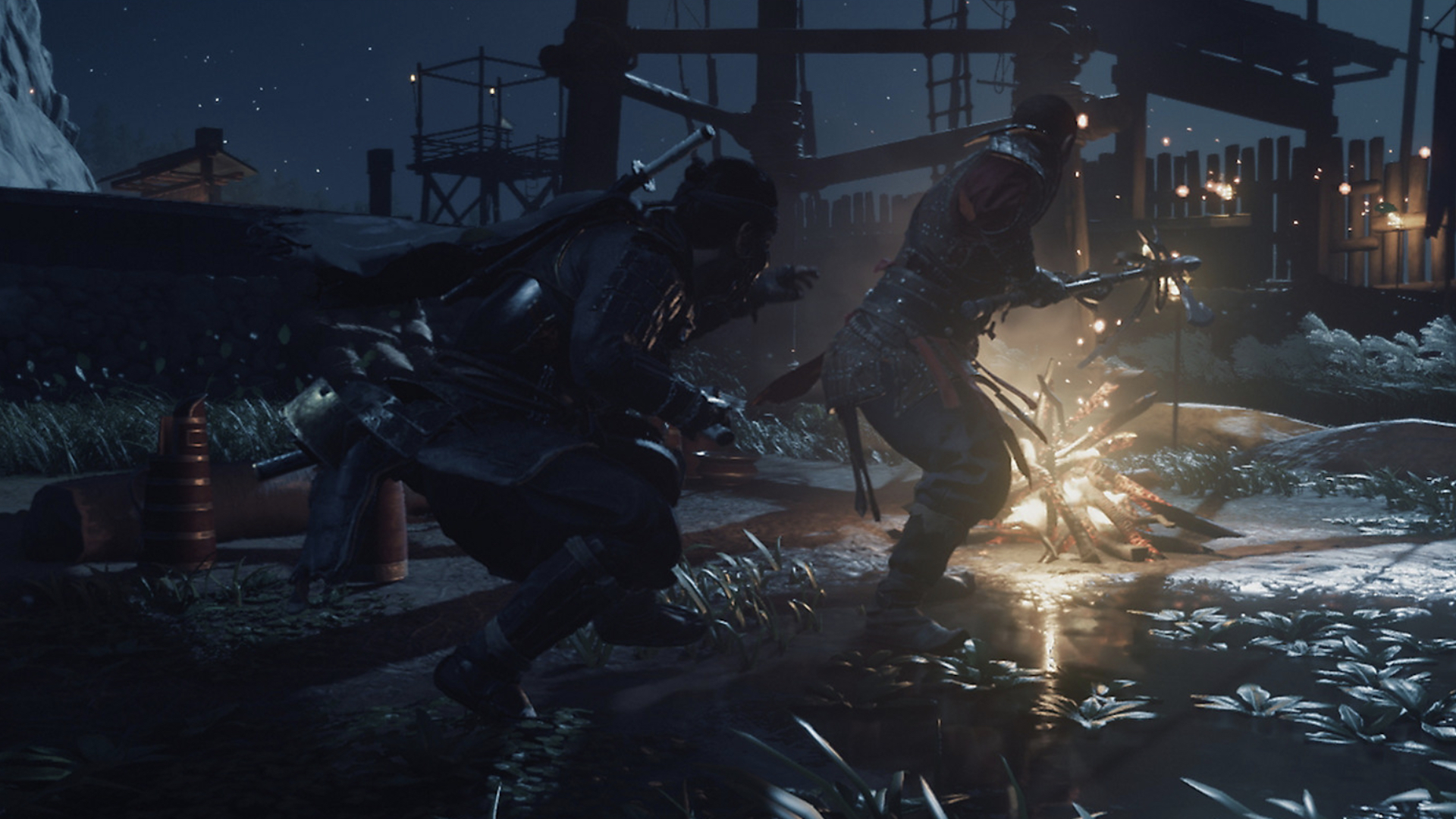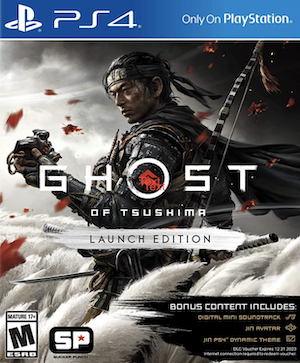
Ghost of Tsushima is a very literal realization of its promise to be the Assassin’s Creed game set in feudal Japan we never got. In fact, given how much it has in common with the pre-Origins era of Ubisoft’s open world franchise, it would not even be accurate to say that it’s like Assassin’s Creed– it is Assassin’s Creed, with a lot of the same strengths and weaknesses. It is comfortably generic and brimming with overly familiar design choices (and issues)- thankfully, even though a lot of the typical Sony polish and ambition to do something new is surprisingly absent from what is likely to be the final big first party game of the PS4 era, there’s still enough to like here to lift Ghost of Tsushima into just a little bit beyond the average Ubisoft style game that it otherwise so slavishly emulates.
In Ghost of Tsushima, you play as Jin Sakai, one of the last remaining samurai on the island of Tsushima following a humiliating and swift defeat against overwhelming invading Mongol forces. In spite of being hopelessly outnumbered though, Jin doesn’t lose hope, immediately setting off on a long quest to free Tsushima from the Mongols’ grasp, and send the invaders back into the sea. Jin quickly learns, however, that to do so, the strict honour-bound samurai code he has lived by his entire life is not going to suffice- the Mongols are fearsome enemies, and unlike samurai, they very much abide by the “all is fair in war” philosophy. And so, Jin must come to terms with the fact that rather than looking his foe in the eye with honour and respect before killing them, he’s going to have to resort to the underhanded tactics that the samurai code has taught him to despise- forget about honour, and defeat the enemy at all costs.
"Ghost of Tsushima is comfortably generic and brimming with overly familiar design choices (and issues)- thankfully, even though a lot of the typical Sony polish and ambition to do something new is surprisingly absent from what is likely to be the final big first party game of the PS4 era, there’s still enough to like here to lift Ghost of Tsushima into just a little bit beyond the average Ubisoft style game that it otherwise so slavishly emulates."
It’s a fascinating premise against the backdrop of a setting that instantly grabs hold. Jin’s internal conflict – often magnified by external factors, such as his uncle and mentor, a fellow samurai who disapproves of Jin’s tactics – makes for a riveting arc for the character, brought to life by excellent performances from all the actors who play the most major characters in the story. Something else that stands out are the game’s main cutscenes, which boast stunning cinematography, stylish camera angles, and fantastic, swelling music, all of which is used to highlight the dramatic nature of the story and the drop-dead beauty of the world it takes place in.
That world is, in fact, one of the game’s biggest strengths, to no one’s surprise. Sucker Punch’s version of the island of Tsushima is bold and beautiful, large and varied. It is full of colours – bright, vivid, and stylistically exaggerated to great effect – and you’re never too far away from chancing upon the next stunning sight that’ll have you staring at it with your mouth agape. Tsushima is also very windy, and watching entire forests and massive fields gently swaying against gusts of wind made me feel things I’ve rarely felt while playing open world games.
These moments of stunning, natural beauty are among the biggest reasons to explore the island of Tsushima, but there are other reasons as well. Exploration is, in fact, another one of the game’s strong suits, and one area where it is very much not like Assassin’s Creed. With no map markers, compass, mini-map, or intrusive on-screen UI prompts to help with navigation, when you’re exploring the island of Tsushima, you rely only on the world itself to guide you, and on the Guiding Wind to lead you to your destinations.
In the absence of those things, however, exploration feels so much more organic. Rather than choosing a point of interest on a map screen and then beelining to it to cross if off my checklist of things to do, I was instead always on the lookout for things in the surroundings to distract me and whisk me away from whatever quest I was currently on. Foxes and golden birds in fields and forests would lead me to shrines and side quest locations, torii gates would lead me to short platforming challenges that would reward me with powerful new charms, plumes of smoke in the distance would lead me to new tasks. And since I had no marker on a compass or GPS on a mini-map to keep me focused, I felt like exploration was far less mechanical than it usually is in modern AAA open world games.
"Tsushima is full of colours – bright, vivid, and stylistically exaggerated to great effect – and you’re never too far away from chancing upon the next stunning sight that’ll have you staring at it with your mouth agape."
But while Ghost of Tsushima echoes the likes of Breath of the Wild and Red Dead Redemption 2 in terms of how it encourages players to explore its beautiful world, in terms of the activities that the world is populated by, the game very much feels like Assassin’s Creed. More than anything else, that’s because those things I mentioned earlier are used excessively, to the point where they lose their charm and – eventually – effectively become quest markers disguised as things in the game’s world. Once I had followed a golden bird through the woods for the umpteenth time, to be led to an activity that I had done countless times before, I realized that Ghost of Tsushima had managed to gameify the very devices it had been using to make sure its world wasn’t gameified.
That repetitive, formulaic structure is something that is painfully apparent in the game’s quest design as well, especially the Tales, which is what side quests are called in Ghost of Tsushima. Though there are a few highlights – such as some of the character-centric Tales that serve to develop the some of the supporting cast, or the Mythic Tales that lead you to better weapons and abilities – by and large the quests in Ghost of Tsushima are full of rote activities that have been done to death in open world games. Investigating crime scenes, following tracks, trailing missions, clearing forts of enemies, rescuing peasants from Mongols, and a whole smattering of annoying insta-fail stealth missions- it’s all here in Ghost of Tsushima, each found in abundance.
It doesn’t help that these side quests have the most uninteresting setups from a narrative standpoint. Side quests also stand in stark contrast to the game’s main story moments in terms of production values, to the point that they almost feel like they’re from a different game. NPCs have weird-looking faces and are poorly voiced, lip syncing is all over the place, animations are awkward and stiff, and cutscenes are framed in the most stilted, bland way possible. All of these cutscenes are accompanied by black bars, and though these black bars certainly do give a cinematic flair to the cutscenes in the main story moments, here, they only serve to highlight the contrast between their intent and the actual quality of what’s going on on-screen.
The entire game, in fact, is wildly inconsistent when it comes to production values. As I’ve mentioned before, the art design in Ghost of Tsushima is absolutely fantastic, but from a technical perspective, there’s no doubt that the game has seen major visual downgrades from everything that Sony showed off prior to launch. Textures often look bland up close, assets in the distance lack detail, and there are also plenty of animation glitches (even without glitches, the way characters animate during gameplay seems choppy). There are also some frame rate issues (though not so much to impact gameplay in any significant way), while lighting in particular doesn’t look nearly as impressive as what the game’s pre-release trailers had promised. Don’t get me wrong, this is still a great looking game- just don’t expect it to look as impressive as other Sony first party games like God of War, The Last of Us Part 2, or Horizon Zero Dawn.
"While Ghost of Tsushima echoes the likes of Breath of the Wild and Red Dead Redemption 2 in terms of how it encourages players to explore its beautiful world, in terms of the activities that the world is populated by, the game very much feels like Assassin’s Creed."
Thankfully, Ghost of Tsushima has one thing going for it that is so ridiculously good, so unbelievably enjoyable, that it helps the game overcome many of its biggest issues- the combat. On paper, the combat here is a blend of Sekiro: Shadows Die Twice and – you’re probably sick of hearing this by now – the older Assassin’s Creed games. Ghost of Tsushima takes the best of both worlds, adds a couple of its own flourishes on top, and delivers some of the best melee combat I’ve experienced in a game in recent memory.
Rather than mashing the attack button and wailing on enemies till they drop, Ghost of Tsushima asks that you approach combat how a samurai would- patiently. Both you and the enemies you take on can fall to just a couple of well-timed attacks, which means you always have to be on the defensive, waiting for an enemy to make a move so that you can dodge or parry, break its defense, and deal a couple of deadly slashes with your katana in the brief window that follows. Enemies also come at you with different tactics and weapons. Big brutes with massive axes and spears might charge at you with unblockable attacks that you have to dodge, swordsmen will surround you and slash at you with quick flurries, while archers will shoot at you from a distance.
Each enemy type requires a different strategy, which takes the form of stances. Jin can use four different stances during combat (three of which you have to unlock) and each is more powerful against particular kinds of enemies. The Stone Stance, for instance, is best used against enemies that use swords, but if it’s an enemy wielding a spear that you’re fighting, the Wind Stance will be far more effective. Combat really comes into its own when Jin comes up against large group of enemies that have multiple enemies of multiple types, which means switching between stances on the fly while keeping an eye on enemies to make sure you can block, dodge, or parry as and when needed is what defines every fight.
It helps that switching between stances is very easy. You simply hold R2, which essentially pauses the game, and use one of the face buttons to choose a different stance. It happens in a flash, and the seamless transition ensures that you’re constantly changing stances in the midst of tense fights to combat different threats. When things really kick into gear, Ghost of Tsushima’s fights almost looks like a choreographed dance (helped in no small way by the excellent combat animations). And while much of the rest of the game had started feeling repetitive to me after some hours, every combat encounter was equally thrilling and enjoyable, right up until the credits rolled (I never got tired of the incredible Standoff duels either). That the combat is wholly reliant on skill and precision rather than things such as gear score or your level made it feel that much more rewarding.
"When things really kick into gear, Ghost of Tsushima’s fights almost looks like a choreographed dance."
Of course, as the game’s central premise and its very name imply, combat is just one side of the coin here. The other side is stealth- which is as bland and uninteresting as the combat is incredible. The tools you have at your disposal during stealth are rudimentary – hiding in tall grass, distracting enemies, using smoke bombs, and what have you – and what’s worse is that the game never encourages you to use them in anything but the most boring, basic ways. It doesn’t help that enemy AI during stealth is astoundingly incompetent, which means that cheesing stealth to take out multiple enemies while they’re bumbling about is entirely possible. More often than not – especially given how excellent the combat is – I found myself wanting to avoid stealth (which made the forced insta-stealth sections I mentioned earlier that much more annoying).
Honestly, I could go on and on about all the issues I’ve encountered while playing Ghost of Tsushima. It’s not a perfect game, and many of its issues are far from minor. It’s surprisingly unpolished, especially for a Sony first party release, and the vast majority of the game is also quite generically designed. Thankfully, Sucker Punch’s open world samurai epic has plenty else going for it. Thanks to its stellar combat, gorgeous world, and engaging exploration, Ghost of Tsushima manages to brute force its way through a laundry list of problems to deliver an experience I couldn’t help but thoroughly enjoy- which, in the end, is what matters more than anything else.
This game was reviewed on the PlayStation 4.
The world is lush, beautiful, and vivid, thanks to excellent art design; No map markers or intrusive UI elements means exploration feels much more organic; Incredible combat; Jin’s internal conflict drives an interesting story that is largely well-told; The primary story cutscenes have excellent cinematography; Solid performances for the main characters; Great music.
Repetitive side quests and open world activities; Rote, formulaic quest design, especially for the vast majority of the side quests; Plenty of technical problems, including lip syncing issues, occasionally bland textures, choppy animations, frame rate drops, and more; Significant visual downgrade from what was shown off pre-release; Poor stealth, thanks to incompetent AI and rudimentary mechanics.




















